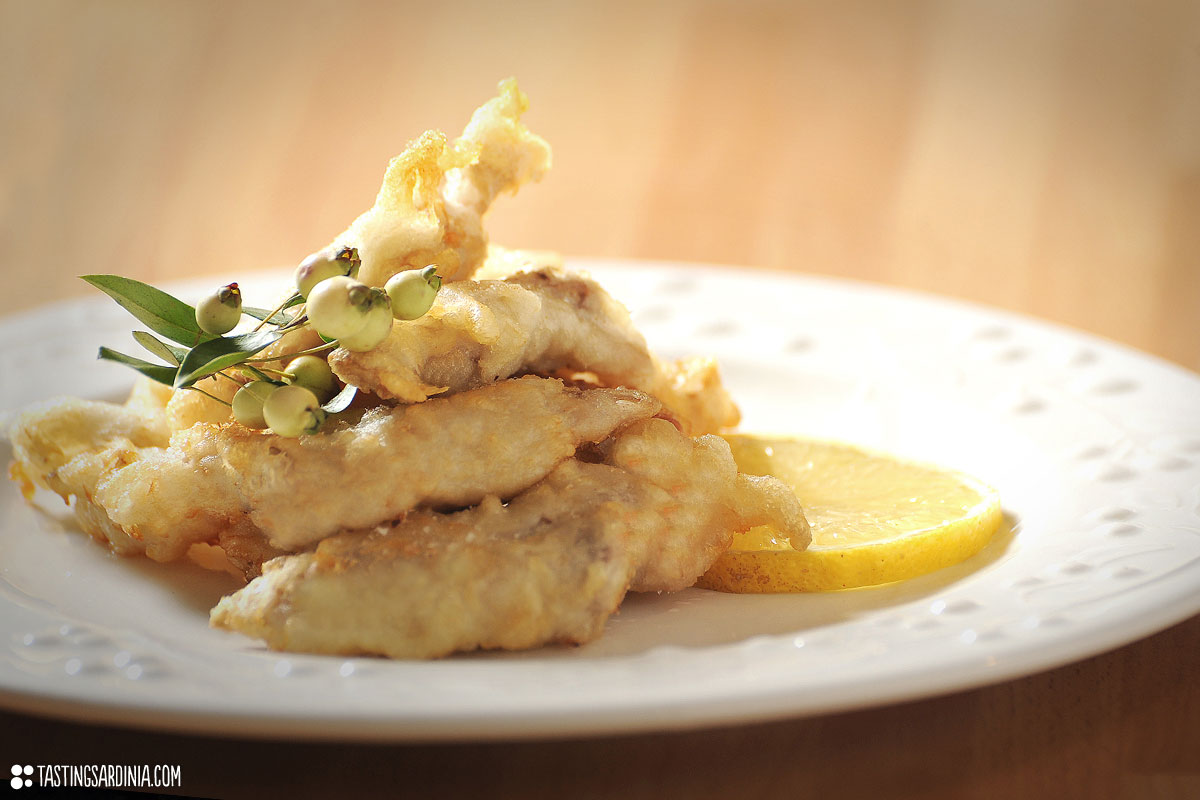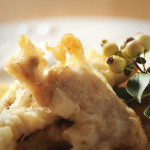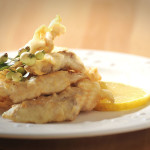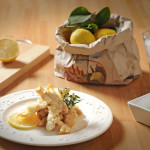prep time: – cook time:
“It’s a long way to the top if you wanna rock&roll…” Definitively it is not a dish, rather this is rock&roll! The first time I had them cooked during a cooking lesson, the mates I was with where just stunned. At first glance they might be shocking but once you give them a try immediately you get crackers about them. Sardinians simply love them and consider this simple and colourful dish a pure delicacy.
Ingredients
- 4 already cleaned lamb feet
- 100 gr Flour
- 100 ml icy water
- salt as much as suffices
- 1 egg
- 1 lemon
- 1 litre peanut oil
You are just lucky enough if you manage to find them already cleaned at the butcher shop; I wouldn’t recommend to anyone to tackle this miserable task.
Lamb feet (already cleaned) have to be boiled in salty water for 30/40 minutes, you understand they are done when the main bone detach easily from the skin. If the cooking time is well guessed it is simple to cut lengthwise the feet in two halves. Lay them on a kitchen cloth to be perfectly drained and focus on the tempura.
Most people think it is very difficult to prepare a perfectly light and simple tempura batter, but I am sure if you follow my tips you will be more than able to make a brilliant tempura. When you are dealing with such a preparation you have to keep under control mainly two different steps: 1. the temperature of the oil; 2. the formation of gluten in the batter.
To have a nice and crispy tempura you should try to avoid the formation of gluten working with low temperatures and not stiring the flour too much.
To make the tempura pour in a large bowl the flour, the egg, the lemon juice and the cold water (better if it is icy), and mix it gently. You shouldn’t stir it too much, leave it with some lumps: if you work the tempura too much the flour will form gluten responsible for the dough-like consistency of the fried crust promoting the absorption of oil. Tempura should be prepared shortly before the frying oil is ready, this tip too is to reduce the formation of gluten as well.
Hit the peanut oil in a large frying pan, better with an important bottom. To guess when the temperature is perfect you will pour just a drop of tempura batter into the frying pan if it reaches the bottom and gets afloat immediately it means it is ready. Fry few pieces per time. When they are crusty and golden place them on some kitchen paper to be drained.
Serving
Place quickly on a flat plate, they should be eaten still hot. Try to work with the vertically placement since they have a flat shape the composition will gain something. I have used few leaves of myrtle to add some contrast and a whole slice of lemon.
Grandmother’s tip
I will summarize all the tips you need to make a perfect tempura: the water has to be chilly; when you mix up the flour not stir it too much; if you have some lumps leave them in the batter; fry few peaces at the time; pour a reasonable amount of oil; use only peanuts oil; check carefully for the right oil temperature; try not to overhit the oil; eat them as soon you fry them, still warm.
My own way
To make a regular batter you really need to keep it as cold as you can while dipping the vegetables. Some tend to put some ice in it; I personally prefer to lay a stainless steel bowl on a bigger container with icy water. This way you will manage to keep it ice-cold avoiding the melting of the ice that inevitably will dilute the batter changing its viscosity.
If you want a light white tempura you shouldn’t add the egg. It depends on your personal taste, the pictures shown in this article were shot using the egg.
It is nice to mix some lemon juice while making the batter, it is a perfect match with the particular lamb taste and helps to cut the fatty feeling in your mouth. Few drops on the fried feet before serving is really nice too.
Tempura is a light batter made of cold water or sometimes sparkling water and soft wheat flour (cake, pastry or all-purpose flour). Eggs, starch, and/or spices may also be added. Tempura batter is traditionally mixed in small batches using chopstiks for only a few seconds, leaving lumps in the mixture that, along with the cold batter temperature, result in the unique fluffy and crisp tempura structure when cooked. The batter is often kept cold by adding ice, or by placing the bowl inside a larger bowl with ice in it. Overmixing the batter will result in activation of wheat gluten, which causes the flour mixture to become chewy and dough-like when fried.
Specially formulated tempura flour is available in worldwide supermarkets. This is generally light (low-gluten) flour, and occasionally contains leaveners such as baking powder.
Mirto (sa murta in Sardinian language) is myrtus or myrtle in English. It is a genus of flowering plants in the family “Myrtaceae”, described by Linnaeus in 1753.
Over 600 names have been proposed in the genus, but nearly all have either been moved to other “genera” or been regarded as synonyms.
In Sardinia Sa murta is very popular for two main uses that are pretty much widespread in the whole territory. The first is as a popular liqueur. It is obtained from the myrtle plant through the alcoholic maceration of the berries or a compound of berries and leaves. Myrtle grows freely in Sardinia, where the liqueur was consumed as part of a local niche market.
The second use is as a fragrance to flavour and wrap the suckling roasted piglet: the Sardinian signature dish par excellence, probably the symbol of an entire and extremely simple cuisine.











